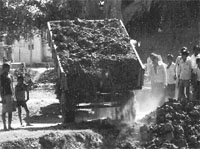Hardwar: Not without help
 While the industrial complex of the Bharat Heavy Electricals Limited ( bhel ) boasts of lower incidence of malaria due to the efforts of the civil maintenance department of the bhel and the mrc , the Hardwar city continues in its battle against mosquitoes.
While the industrial complex of the Bharat Heavy Electricals Limited ( bhel ) boasts of lower incidence of malaria due to the efforts of the civil maintenance department of the bhel and the mrc , the Hardwar city continues in its battle against mosquitoes.
In 1986, the mrc started bioenvironmental control within the bhel complex, an area covering 25 sq km. bhel is a huge public sector company with a centrally-managed residential colony and a team of paid staff. The bhel hospital registered 1,129, 1,623 and 3,049 malaria positive cases in 1983, 1984 and 1985, respectively. Previous mosquito control measures, like spraying of ddt and hexachloro cyclo hexane ( hch ), had very little impact on the increasing trends of malaria, partly due to vector resistance and irregular spraying, which also led to alarming levels of pollution in Hardwar.
Work on reducing breeding grounds was undertaken by the mrc in collaboration with the civil maintenance department of bhel . People were involved in establishing nurseries, tree plantations and improvement of toilets, which had an impact on mosquito breeding. However, the community did not take any initiative on its own. It participated only when the mrc took the initiative. "As long as the disease is there, people treat us like gods. The moment it is controlled, they lose interest,' bemoans V K Dua, station in-charge, mrc , Hardwar.
The programme was continued aggressively for four years, that is till 1990. Thereafter, the focus of mrc shifted to maintenance of the interventions and regular surveillance. "We have instructed the civil maintenance department of the bhel complex to carry it forward. Ours is a research organisation. Our job is only to develop strategies. Carrying it forward is the government's job. Why should we waste our resources in doing someone else's job?' asks Dua. "Now we only work as a monitoring body,' he points out. The mrc monitors the entire campus every fortnight, mainly through surveillance. Whenever needed, it arranges through bhel 's civil maintenance department to make minor interventions such as filling pits, ditches and introducing larvivorous fish. The exercise has produced good results. In the bhel complex, incidence of malaria was reduced by more than 90 per cent in 10 years.
In addition to bringing down malaria, the level of pesticide pollution in the bhel complex was found to be much lower than in the adjoining areas. A 1994 mrc study in Hardwar found that the concentrations of hch and ddt in soil, drinking water and human blood were 10 to 200 times higher in the nearby locality of Bahadrabad, where insecticides are sprayed, than in the bhel complex where pesticides have not been used since 1986. Considering the toxic effect of pesticides, bioenvironmental control has a distinct advantage over methods such as spraying.
Local residents have been able to feel the difference in terms of the decrease in incidence. Shalini Dutta, a physician who has been handling cases of malaria for 20 years, says: "The mrc has done a very good job. The annual incidence of malaria has decreased substantially.' Although a decrease in incidence of malaria is acknowledged unanimously, the mosquito nuisance remains.
This paradox raises a question: if the mosquitoes remain, would malaria make a comeback and undo everything that the mrc has achieved so painstakingly? "It poses no threat of resurgence as most of the mosquitoes are of the Culex species and do not carry malaria parasites,' claims Sharma of the mrc . But how is that despite cleaner sanitation, mosquitoes still preponderate in the campus? "The bhel complex is clean but the surrounding areas are not. These mosquitoes have a tremendous flight range (up to 2-3 km) and due to their import from the adjoining dirtier areas, people still face problems,' explains S P Sethi, a technical assistant with mrc , Hardwar. Is the adjoining area of bhel dirty? "The sanitation condition of the town is bad,' agrees Y S Bisht, district malaria officer, Hardwar General Hospital. "Even our surveillance system is faulty,' he adds.
But then what is the use of carrying out bioenvironmental vector control in a selected area and leaving the surrounding areas filthy? To protect the bhel campus from mosquitoes
